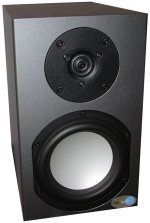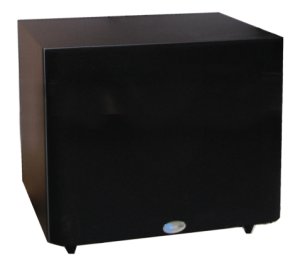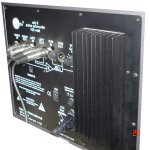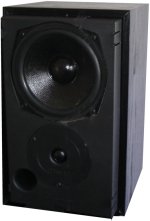

|
|||||
The first
effects unit I owned was a Yamaha digital reverb unit which was very
inflexible. After a long time I invested in a MIDI effects unit and
knowing the good reputation
of Alesis effects units, chose the Midiverb 4.
Alesis Midiverb 4
This unit offers many great studio effects, some subtle and some wierd and wacky all of which can be changed using MIDI program information.
This picture has not
turned out too well has it? The main problem is the light reflecting in
the display. Oh and I have just noticed that to this day I have never
removed the protective plastic cover from the display!
Digitech studio quad V2

I have since swapped the Midiverb
for a Digitech
Studio Quad. This unit qives 4 concurrent effects which can be used
individually or is various chain setups to give many different effects
variations. It is fully midi aware.
Monitors
Some background information
There are many tips on mastering music properly in music magazines such as Sound on Sound and Computer Music. Here are a few of mine...
Referencing of different systems
During music creation it is really important to periodically reference your music on different sound systems so you end up with a piece of music that sounds balanced on lots of different systems. Your music will probably end up being played on lots of different systems, most of which are not ideal, sometimes not even stereo! I used to create stuff that sounded perfect on my old disco speakers (below) but absolutely shockingly awful on anything else!!
I ended up jumping from the studio to the hi-fi downstairs (to test quality) to the car (to test bass :) ) and back again and the music was much more acceptable.
Now I have two monitor systems, one high end professional, one low end hi-fi (with a switch between the two) and the headphones. From time to time I will play work in progress in the car as well. I found playing a track out of the studio is a great way to sort out how I am going to progress with it if I have run out of ideas and can't get into it any more.
Stereo imaging
I always use head phones at times too, to check stereo imaging it is essential because your ears are intimately glued to their respective channels and any affects the room has on the sound are eliminated. I found a nice pair of Sennheiser HD 570s which my ears really liked, but everyone's tase is different. Any sounds in your mix which may be a little too hard panned on the speakers suddenly become very obvious on the phones giving you bount of headaches and dizzyness forcing you to sort them out!
Bass
Using a good pair of monitors with good bass, or a sub can really help develop good bass lines but dont forget your average punter (unless you supply sound systems to all your fans(!)) will probably have something uncapable of reproducing your deeeeep bass - or certainly not quite how you intend so it's really useful to audition on some small book shelf speakers (like the diamonds) to see if your bass is lost.
To "find" a bass again, try adding a higher pitched sound or tone onto your bass to it is more mid - compatible too. Another thing I found really useful is playing with distortion which can add good effects to the sound as well as add a lot of higher harmonics. Waves Maxxbass looks like it could really help here as it does exactly that - adds higher harmonics and reduces low fundamentals, so even tiny systems can give the impression of enhanced bass. I have avoided buying this plugin as I have a concern it will make me rely too much on the technology to correct my "bad mixing" and optimise my track for one type of system only to find it does not sound too good on another system. so yes - yet again its the hard way for me :)
Click here for more info on Waves and other plugins.
Panning
Panning of stuff is important to make a mix sound life like and more stereo, but make sure bread and butter sounds - bass line and often bass and maybe snare are centered. The centering of bass means the system playing the track can deliver max bass using both its channels and when it comes to deep sounds you can't tell if its coming from left or right anyway.
Waves and other plugin manufacturers have plugins which can visualise the panning and spacial utilisation of a sound and it can be quite elightening to view your track is something as simple as the "scope" plugin (free with Cubase 5) set to analyser mode to view how mono your track actually is!

There are many tips on mastering music properly in music magazines such as Sound on Sound and Computer Music. Here are a few of mine...
Referencing of different systems
During music creation it is really important to periodically reference your music on different sound systems so you end up with a piece of music that sounds balanced on lots of different systems. Your music will probably end up being played on lots of different systems, most of which are not ideal, sometimes not even stereo! I used to create stuff that sounded perfect on my old disco speakers (below) but absolutely shockingly awful on anything else!!
I ended up jumping from the studio to the hi-fi downstairs (to test quality) to the car (to test bass :) ) and back again and the music was much more acceptable.
Now I have two monitor systems, one high end professional, one low end hi-fi (with a switch between the two) and the headphones. From time to time I will play work in progress in the car as well. I found playing a track out of the studio is a great way to sort out how I am going to progress with it if I have run out of ideas and can't get into it any more.
Stereo imaging
I always use head phones at times too, to check stereo imaging it is essential because your ears are intimately glued to their respective channels and any affects the room has on the sound are eliminated. I found a nice pair of Sennheiser HD 570s which my ears really liked, but everyone's tase is different. Any sounds in your mix which may be a little too hard panned on the speakers suddenly become very obvious on the phones giving you bount of headaches and dizzyness forcing you to sort them out!
Bass
Using a good pair of monitors with good bass, or a sub can really help develop good bass lines but dont forget your average punter (unless you supply sound systems to all your fans(!)) will probably have something uncapable of reproducing your deeeeep bass - or certainly not quite how you intend so it's really useful to audition on some small book shelf speakers (like the diamonds) to see if your bass is lost.
To "find" a bass again, try adding a higher pitched sound or tone onto your bass to it is more mid - compatible too. Another thing I found really useful is playing with distortion which can add good effects to the sound as well as add a lot of higher harmonics. Waves Maxxbass looks like it could really help here as it does exactly that - adds higher harmonics and reduces low fundamentals, so even tiny systems can give the impression of enhanced bass. I have avoided buying this plugin as I have a concern it will make me rely too much on the technology to correct my "bad mixing" and optimise my track for one type of system only to find it does not sound too good on another system. so yes - yet again its the hard way for me :)
Click here for more info on Waves and other plugins.
Panning
Panning of stuff is important to make a mix sound life like and more stereo, but make sure bread and butter sounds - bass line and often bass and maybe snare are centered. The centering of bass means the system playing the track can deliver max bass using both its channels and when it comes to deep sounds you can't tell if its coming from left or right anyway.
Waves and other plugin manufacturers have plugins which can visualise the panning and spacial utilisation of a sound and it can be quite elightening to view your track is something as simple as the "scope" plugin (free with Cubase 5) set to analyser mode to view how mono your track actually is!
Main monitoring system - Bluesky Prodesk
The top boxes

These are the SAT5 monitors, each having 60 + 60W bi-amped drivers, so each driver has its own amplifier to minimise distortion across the bands, as it should be. There is a 80Hz filter switch to use when the sub is inline.
The sub unit

This is the SUB8 unit which has a 100W powered 8" bass driver. It works below 80Hz taking over from the SAT5's to complete the audio picture. Don't be fooled that it is "only" 8 inch as the bass is amazing and the cone can travel a long long way. The SUB 12 must be phenominal. The SAT5's can be used alone for smaller installations, perhaps where using the sub would make peeved neighbours appear with annoying regularity.

I have been using the Blue Sky Prodesk 2.1 monitoring system for a long time now. Its sound quality I wonderful and I never have a problem getting enough bass! I have had fun getting the sub placed correctly though. It has made so much difference using a decent reference system to produce music on and every sound is reproduced clearly and in a way that does not give you a headache after hours of use.
Sub rear view

This is a rear view of the sub to show the connections made to the mixer and up to the top boxes. Note the sub gain is -3dB, a setting recommended as a starting point for a smaller room. One annoying thing about this is that whenever I reach for the power switch there is a fair chance the gain will be changed by mistake!
Mission 760s and Cambridge Hi-Fi amp
The idea of using the Missions and the Cambridge was to get a system similar to the average home setup up with typical bookshelf speakers to compare during making the music. Sometimes its a constant case of A/B comparisons during production. It's also handy to use them when playing with new syth sounds with the possibility of very low sub bass transients that may damage the precious Blue Skys but which get missed out by the bookshelf system! The Missions came from a very nice lady on Freecyle and it's fair to say they are being put to very good use!
The Amp was just bought new from Richer Sounds. One thing I have noticed is it has really quiet inputs so you need something quite beefy to drive it! When running directly from a computer (no mixer) I had to connect the headphone output into the tape or whatever input of the amp, the line out was not sufficient!
Click here for historical information of devices not used any more...
Tracked by dancecrave"; ?>

